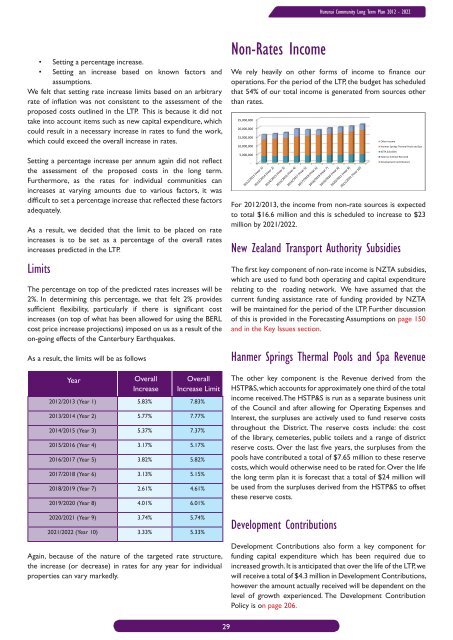Long Term Community Plan 2012-2022 - Hurunui District Council
Long Term Community Plan 2012-2022 - Hurunui District Council
Long Term Community Plan 2012-2022 - Hurunui District Council
You also want an ePaper? Increase the reach of your titles
YUMPU automatically turns print PDFs into web optimized ePapers that Google loves.
<strong>Hurunui</strong> <strong>Community</strong> <strong>Long</strong> <strong>Term</strong> <strong>Plan</strong> <strong>2012</strong> - <strong>2022</strong><br />
• Setting a percentage increase.<br />
• Setting an increase based on known factors and<br />
assumptions.<br />
We felt that setting rate increase limits based on an arbitrary<br />
rate of inflation was not consistent to the assessment of the<br />
proposed costs outlined in the LTP. This is because it did not<br />
take into account items such as new capital expenditure, which<br />
could result in a necessary increase in rates to fund the work,<br />
which could exceed the overall increase in rates.<br />
Setting a percentage increase per annum again did not reflect<br />
the assessment of the proposed costs in the long term.<br />
Furthermore, as the rates for individual communities can<br />
increases at varying amounts due to various factors, it was<br />
difficult to set a percentage increase that reflected these factors<br />
adequately.<br />
As a result, we decided that the limit to be placed on rate<br />
increases is to be set as a percentage of the overall rates<br />
increases predicted in the LTP.<br />
Limits<br />
The percentage on top of the predicted rates increases will be<br />
2%. In determining this percentage, we that felt 2% provides<br />
sufficient flexibility, particularly if there is significant cost<br />
increases (on top of what has been allowed for using the BERL<br />
cost price increase projections) imposed on us as a result of the<br />
on-going effects of the Canterbury Earthquakes.<br />
As a result, the limits will be as follows<br />
Year<br />
Overall<br />
Increase<br />
Overall<br />
Increase Limit<br />
<strong>2012</strong>/2013 (Year 1) 5.83% 7.83%<br />
2013/2014 (Year 2) 5.77% 7.77%<br />
2014/2015 (Year 3) 5.37% 7.37%<br />
2015/2016 (Year 4) 3.17% 5.17%<br />
2016/2017 (Year 5) 3.82% 5.82%<br />
2017/2018 (Year 6) 3.13% 5.15%<br />
2018/2019 (Year 7) 2.61% 4.61%<br />
2019/2020 (Year 8) 4.01% 6.01%<br />
2020/2021 (Year 9) 3.74% 5.74%<br />
2021/<strong>2022</strong> (Year 10) 3.33% 5.33%<br />
Again, because of the nature of the targeted rate structure,<br />
the increase (or decrease) in rates for any year for individual<br />
properties can vary markedly.<br />
Non-Rates Income<br />
We rely heavily on other forms of income to finance our<br />
operations. For the period of the LTP, the budget has scheduled<br />
that 54% of our total income is generated from sources other<br />
than rates.<br />
25,000,000<br />
20,000,000<br />
15,000,000<br />
10,000,000<br />
5,000,000<br />
-<br />
For <strong>2012</strong>/2013, the income from non-rate sources is expected<br />
to total $16.6 million and this is scheduled to increase to $23<br />
million by 2021/<strong>2022</strong>.<br />
New Zealand Transport Authority Subsidies<br />
The first key component of non-rate income is NZTA subsidies,<br />
which are used to fund both operating and capital expenditure<br />
relating to the roading network. We have assumed that the<br />
current funding assistance rate of funding provided by NZTA<br />
will be maintained for the period of the LTP. Further discussion<br />
of this is provided in the Forecasting Assumptions on page 150<br />
and in the Key Issues section.<br />
Hanmer Springs Thermal Pools and Spa Revenue<br />
The other key component is the Revenue derived from the<br />
HSTP&S, which accounts for approximately one third of the total<br />
income received. The HSTP&S is run as a separate business unit<br />
of the <strong>Council</strong> and after allowing for Operating Expenses and<br />
Interest, the surpluses are actively used to fund reserve costs<br />
throughout the <strong>District</strong>. The reserve costs include: the cost<br />
of the library, cemeteries, public toilets and a range of district<br />
reserve costs. Over the last five years, the surpluses from the<br />
pools have contributed a total of $7.65 million to these reserve<br />
costs, which would otherwise need to be rated for. Over the life<br />
the long term plan it is forecast that a total of $24 million will<br />
be used from the surpluses derived from the HSTP&S to offset<br />
these reserve costs.<br />
Development Contributions<br />
Other Income<br />
Hanmer Springs Thermal Pools and Spa<br />
NZTA Subsidies<br />
External Interest Received<br />
Development Contributions<br />
Development Contributions also form a key component for<br />
funding capital expenditure which has been required due to<br />
increased growth. It is anticipated that over the life of the LTP, we<br />
will receive a total of $4.3 million in Development Contributions,<br />
however the amount actually received will be dependent on the<br />
level of growth experienced. The Development Contribution<br />
Policy is on page 206.<br />
29

















